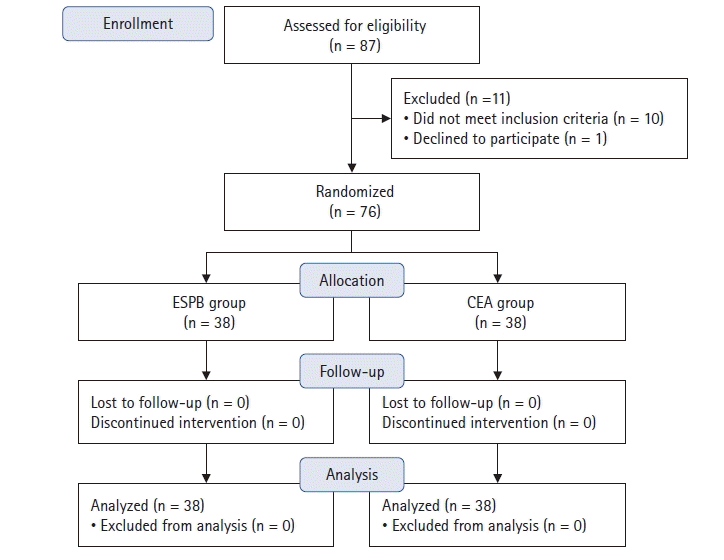1. Rabbitts JA, Palermo TM, Zhou C, Mangione-Smith R. Pain and health-related quality of life after pediatric inpatient surgery. J Pain. 2015; 16:1334–41.
2. Pagé MG, Stinson J, Campbell F, Isaac L, Katz J. Identification of pain-related psychological risk factors for the development and maintenance of pediatric chronic postsurgical pain. J Pain Res. 2013; 6:167–80.
3. Rabbitts JA, Aaron RV, Fisher E, Lang EA, Bridgwater C, Tai GG, et al. Long-term pain and recovery after major pediatric surgery: a qualitative study with teens, parents, and perioperative care providers. J Pain. 2017; 18:778–86.
4. Polaner DM, Taenzer AH, Walker BJ, Bosenberg A, Krane EJ, Suresh S, et al. Pediatric Regional Anesthesia Network (PRAN): a multi-institutional study of the use and incidence of complications of pediatric regional anesthesia. Anesth Analg. 2012; 115:1353–64.
5. Tsui BC, Berde CB. Caudal analgesia and anesthesia techniques in children. Curr Opin Anaesthesiol. 2005; 18:283–8.
6. Kiribayashi M, Inagaki Y, Nishimura Y, Yamasaki K, Takahashi S, Ueda K. Caudal blockade shortens the time to walking exercise in elderly patients following low back surgery. J Anesth. 2010; 24:192–6.
7. Metzelder ML, Kuebler JF, Glueer S, Suempelmann R, Ure BM, Petersen C. Penile block is associated with less urinary retention than caudal anesthesia in distal hypospadia repair in children. World J Urol. 2010; 28:87–91.
8. Balaban O, Koçulu R, Aydın T. Ultrasound-guided lumbar erector spinae plane block for postoperative analgesia in femur fracture: a pediatric case report. Cureus. 2019; 11:e5148.
9. Lima FV, Zandomenico JG, Prado MN, Favreto D. Erector spinae plane block in pediatric orthopedic surgery: two case reports. Braz J Anesthesiol. 2020; 70:440–42.
10. Tulgar S, Senturk O. Ultrasound guided erector spinae plane block at L-4 transverse process level provides effective postoperative analgesia for total hip arthroplasty. J Clin Anesth. 2018; 44:68.
11. Elkoundi A, Bentalha A, Kettani SE, Mosadik A, Koraichi AE. Erector spinae plane block for pediatric hip surgery -a case report. Korean J Anesthesiol. 2019; 72:68–71.
12. Abdulatif M, Mukhtar A, Obayah G. Pitfalls in reporting sample size calculation in randomized controlled trials published in leading anaesthesia journals: a systematic review. Br J Anaesth. 2015; 115:699–707.
13. Wiegele M, Marhofer P, Lönnqvist PA. Caudal epidural blocks in paediatric patients: a review and practical considerations. Br J Anaesth. 2019; 122:509–17.
14. Salim IM, El Rahwan SM, Abu Elyazd MM, Abo Elnasr LM. The analgesic efficacy of ultrasound-guided quadratus lumborum block versus ultrasound-guided caudal block for hip surgery in pediatrics: a prospective randomized study. J Adv Med Med Res. 2021; 33:58–68.
15. Villalobos MA, Veneziano G, Miller R, Beltran RJ, Krishna S, Tumin D, et al. Evaluation of postoperative analgesia in pediatric patients after hip surgery: lumbar plexus versus caudal epidural analgesia. J Pain Res. 2019; 12:997–1001.
16. Tulgar S, Selvi O, Senturk O, Ermis MN, Cubuk R, Ozer Z. Clinical experiences of ultrasound-guided lumbar erector spinae plane block for hip joint and proximal femur surgeries. J Clin Anesth. 2018; 47:5–6.
17. Hernandez MA, Palazzi L, Lapalma J, Cravero J. Erector spinae plane block for inguinal hernia repair in preterm infants. Paediatr Anaesth. 2018; 28:298–9.
18. Aliena SP, Lini C, Chirayath JJ. Comparison of postoperative analgesic effect of caudal bupivacaine with and without ketamine in Pediatric subumbilical surgeries. J Anaesthesiol Clin Pharmacol. 2018; 34:324–7.
19. Thomas ML, Roebuck D, Yule C, Howard RF. The effect of volume of local anesthetic on the anatomic spread of caudal block in children aged 1-7 years. Paediatr Anaesth. 2010; 20:1017–21.
20. Ahiskalioglu A, Tulgar S, Celik M, Ozer Z, Alici HA, Aydin ME. Lumbar erector spinae plane block as a main anesthetic method for hip surgery in high risk elderly patients: initial experience with a magnetic resonance imaging. Eurasian J Med. 2020; 52:16–20.
21. Abdelnasser A, Zoheir H, Rady A, Ramzy M, Abdelhamid BM. Effectiveness of ultrasound-guided erector spinae plane block for postoperative pain control in hip replacement surgeries; a pilot study. J Clin Anesth. 2020; 62:109732.
22. Crellin D, Harrison D, Santamaria N, Babl FE. Comparison of the psychometric properties of the FLACC scale, the MBPS and the observer applied visual analogue scale used to assess procedural pain. J Pain Res. 2021; 14:881–92.




 PDF
PDF Citation
Citation Print
Print





 XML Download
XML Download